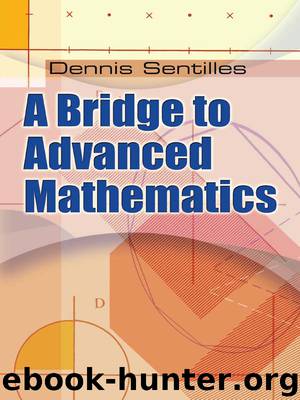A Bridge to Advanced Mathematics by Dennis Sentilles

Author:Dennis Sentilles
Language: eng
Format: epub, mobi
Publisher: Dover Publications, Inc
Published: 2013-02-27T16:00:00+00:00
(b) where .
(c)
(d) .
7. THE AXIOM QF CHOICE
Mathematicians are yet skirmishing over this one. Basically it can be viewed as a special principle of logic to be applied to infinite classes. In fact, on its surface it appears to be so patently logical, or reasonable, that it was not even recognized as an assumption when first used.
In 1904 the mathematician Zermelo proved what is called the Well-Ordering Theorem, Consider the order relation “<” on the set of real numbers . It has the properties:
(1) If a ≠ b, then a < b or b < a.
(2) If a < b, then a ≠ b.
(3) If a < b and b < c, than a < c,
Now consider the subset S = (0, 1) of . This set does not have a first or smallest element! For, 0 ∉ S and if x ∈ S then x/2 ∈ S and hence there is no s ∈ S such that s ≤ x for all x ∈ S, Recall that in the set , on the other hand, every non-empty subset does have a smallest element. This indicates that there is something different about ordering the real numbers as opposed to ordering the natural numbers. Zermelo’s well ordering theorem says that given any set T, not necessarily a set of numbers, there can be defined between the elements T an order relation “<” having the abstract properties (1), (2) and (3), and the additional property that for any subset S of T, S does have a smallest element in the ordering defined. Such a set T is said to be well ordered.
Unfortunately Zermelo’s theorem does not say how to define the order relation, but only that one can be defined. No one has yet defined an order relation on for which (say) the set S = (0, 1) has a smallest element. From the discussion above, an order relation with this property would necessarily be different from the usual order relation of a < b. At any rate, the whole idea was a bit too much for mathematicians to take and they began examining Zermelo’s proof of the “well ordering” theorem. It was discovered that the proof depended on the following assumption, which Zermelo did not recognize or admit as an assumption, probably because it seemed so natural.
The Axiom of Choice. Let be a collection of mutually disjoint nonempty subsets of a universal set U. Then there exists a set B consisting of exactly one element taken from each set .
The axiom of choice says, no more and no less, that one can pick an element out of each set and collect these elements together into a new set. For example, let . The axiom of choice says a set B = {1, 5, 4} exists. No big thing there! This set could also be obtained from Axiom 4. For, let p(x): x = 1 ∨ x = 5 ∨ x = 4. Then B = {x: p(x)}. The catch comes when the set contains infinitely many sets.
Download
A Bridge to Advanced Mathematics by Dennis Sentilles.mobi
This site does not store any files on its server. We only index and link to content provided by other sites. Please contact the content providers to delete copyright contents if any and email us, we'll remove relevant links or contents immediately.
| Algebra | Calculus |
| Combinatorics | Discrete Mathematics |
| Finite Mathematics | Fractals |
| Functional Analysis | Group Theory |
| Logic | Number Theory |
| Set Theory |
Modelling of Convective Heat and Mass Transfer in Rotating Flows by Igor V. Shevchuk(6406)
Weapons of Math Destruction by Cathy O'Neil(6215)
Factfulness: Ten Reasons We're Wrong About the World – and Why Things Are Better Than You Think by Hans Rosling(4713)
A Mind For Numbers: How to Excel at Math and Science (Even If You Flunked Algebra) by Barbara Oakley(3256)
Descartes' Error by Antonio Damasio(3248)
Factfulness_Ten Reasons We're Wrong About the World_and Why Things Are Better Than You Think by Hans Rosling(3216)
TCP IP by Todd Lammle(3154)
Fooled by Randomness: The Hidden Role of Chance in Life and in the Markets by Nassim Nicholas Taleb(3080)
Applied Predictive Modeling by Max Kuhn & Kjell Johnson(3041)
The Tyranny of Metrics by Jerry Z. Muller(3028)
The Book of Numbers by Peter Bentley(2929)
The Great Unknown by Marcus du Sautoy(2662)
Once Upon an Algorithm by Martin Erwig(2621)
Easy Algebra Step-by-Step by Sandra Luna McCune(2604)
Lady Luck by Kristen Ashley(2554)
Police Exams Prep 2018-2019 by Kaplan Test Prep(2516)
Practical Guide To Principal Component Methods in R (Multivariate Analysis Book 2) by Alboukadel Kassambara(2513)
All Things Reconsidered by Bill Thompson III(2371)
Linear Time-Invariant Systems, Behaviors and Modules by Ulrich Oberst & Martin Scheicher & Ingrid Scheicher(2346)
